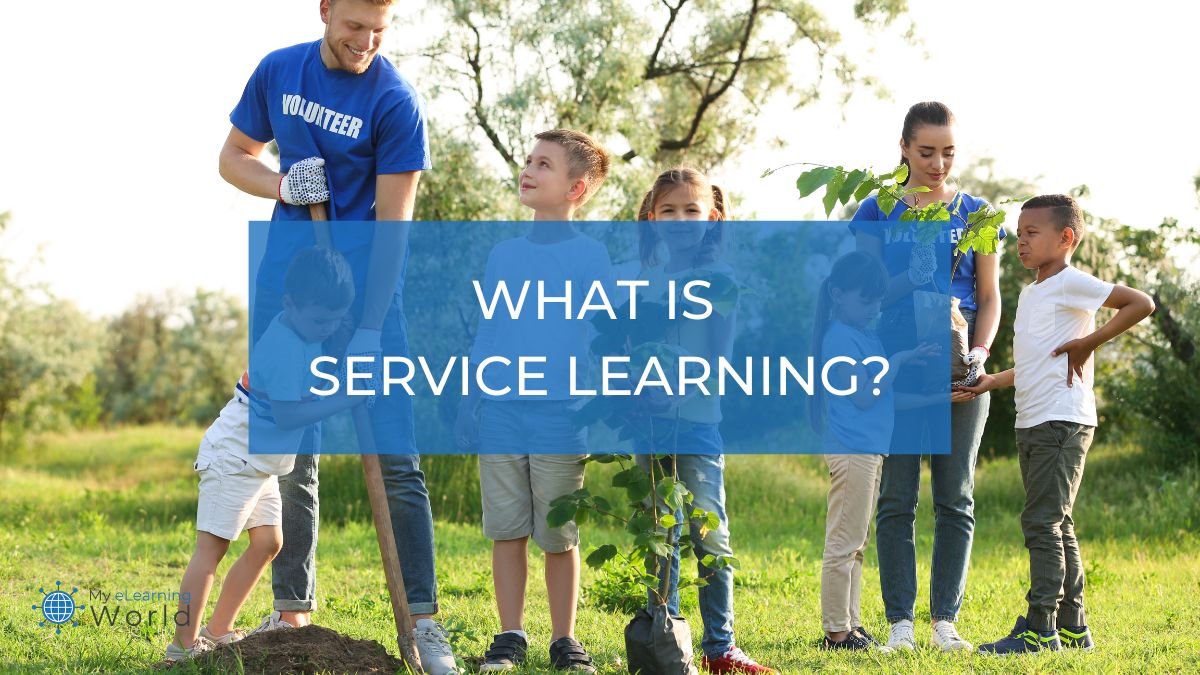Community service has been part of the public education sphere for many years. As a teacher myself, I truly believe that encouraging young people to step up for their communities has many benefits. Whether it’s cleaning up a local park or playground, helping the homeless, fostering pets up for adoption, or raising money for a community need, it’s always a victory when young people can take action to better their world.
Some teachers take community service even further. Instead of simply requiring their students to spend a certain number of hours doing volunteer work, these teachers build their learning objectives around the community service itself. Entire units of study are thoughtfully aligned with public outreach objectives and projects, so that students learn academic content as they work together to serve their communities.
This is what’s known as service learning.
Why Do Some Teachers Choose Service Learning?
Service learning is a valuable way to help students connect what they’re learning in the classroom to the real world. By engaging in social outreach activities, students get a firsthand look at how what they’re learning actually leads to positive change.
I’ve found that service learning can create a higher level of student engagement, as well. Ask any teacher you know, and they’ll tell you that when students are able to work on projects that actually matter to them and their communities, they’re much more likely to put in their best efforts.
Knowing there’s more at stake than just a final grade on their report cards can also motivate those students who might typically be disinterested in school.
A student who may not care much about math might care passionately about beautifying their favorite local park – and suddenly, the equations required to determine how much potting soil or fencing is needed become real, tangible issues, instead of just dull lines in the workbook.
Basing the knowledge and content that students need to know in a real-world setting is an incredibly powerful way to generate legitimate interest. As the author of one recent report noted, “students find personal meaning when service-learning exposes them to encounters that influence their future educational or career goals.”
Filling a need in the community at the same time makes service learning a win-win situation.
How is Service Learning Different?
Service learning is similar in many ways to Project-Based Learning. Both models of teaching are anchored around real-world issues, and both aim to empower students by letting them collaborate and find solutions instead of just memorizing facts.
Service learning, however, has a slightly more defined scope. Projects for Project-Based Learning can be centered around a wide array of topics, problems, or challenges. With service learning, however, any projects completed by students will be directly related to improving the community.
On the other hand, this doesn’t mean that service learning is just community service with a new name. In order for service learning to be academically enriching, teachers need to tie their students’ efforts back to the standards of learning their students are working to achieve.
This means creating the unit with specific, academic learning as the end-goal, rather than just hoping students enjoy the time they spend doing public works.
How Can Teachers Make Service Learning Effective?
Getting the most out of a service learning unit involves some careful planning on the teacher’s end. When done with intention and forethought, though, these units of study can be some of the most rewarding experiences you enjoy with your students all year!
Check out the steps below to get an idea of how some educators go about structuring their service learning units to make them as beneficial as possible.
Brainstorm
The first step to making service learning a reality lies in generating ideas about what your community needs. Is pollution or litter an issue in your hometown? Are local charities in need of assistance, funding, or extra manpower? Is there an outdoor area around your school that you might turn into a nature trail or reading nook?
Depending on their ages, students can join in at any stage of the brainstorming process. Younger students might choose topics presented by the teacher, while older students could conduct research on their own using news sites (think GetEPIC or Newsela) to find issues they think are important.
Allowing your students to vote on the cause they most support is a meaningful way to add value to your service learning unit. Even if the project your class ends up pursuing isn’t unanimously voted in, by allowing every member of the class to have a voice you send a powerful message of respect for each student’s ideas.
Make Connections
Once you have several good ideas on the table, it’s time to start connecting them to what you’re responsible for teaching your students. How can you connect each project to grade-level skills and content?
Many projects and ideas lend themselves naturally to reading, writing, and research, so begin thinking about how you will intentionally weave these skills into the unit.
Adding in math, science, history, or civics standards can also enrich your service learning unit. The only limit here is creativity, so think outside the box as you make the connections between filling a need in your community to helping your students learn new material.
Get the Ball Rolling
Once you’ve landed on a meaningful project and determined how you’ll incorporate grade-level skills, it’s time to get going! An easy way to get everyone on the same page is by letting students start backward, by looking at the final rubric you’ll use to evaluate their service learning.
Go over each step in your community service project, and make sure students understand how the process is linked to what they’re learning in class. Give students plenty of time to ask questions – at the beginning, and throughout the unit.
Whether you plan to have your students work in groups, in partnerships, or independently, it’s important to factor in time for communication as your service learning unit plays out. Check in frequently to make sure everyone is staying on track and adhering to the guidelines you’ve set out.
Evaluate with Care
Throughout your service learning unit, it’s important to provide your students with thoughtful feedback. Stick to your rubric while still making sure to commend every student who is working hard to improve the community.
Since service learning has an academic component, it’s important not to rely solely on the “A for effort” model. Instead, make sure your students have upheld the rigorous standards you’ve set out, and carefully guide them back to the path to success if they seem to be straying. Remember: they’re not just passive volunteers, but active learners solving a problem in their world!
Evaluating their work, either by team or individual student, is an essential piece to keeping a service learning unit focused and productive.
Let Students Reflect On Their Work
Teacher evaluations are important, but student-led critiques also play an important role in service learning units. As your unit comes to a close, allow students to conference either with you or with one another to think back on what went well and what they might change in future projects.
Reflection can also take place in a celebratory way. Letting students share their hard work outside the classroom can be an excellent way to help them really appreciate the impact of their new knowledge and all they’ve accomplished.
Whether it’s a schoolwide event, a website to be shared, or a display or performance at a community center or park, getting your students out there to share what they’ve achieved can really drive home how meaningful their work has been!
Where Does Service Learning Fit In?
One of the things I love about service learning is how adaptable it is for different grade levels and subject areas. That said, this type of unit is especially well-suited to civics classrooms, as these standards of learning are typically centered around community to begin with.
That’s not to say, however, that service learning can’t be a wonderful way to tackle other subjects too! Since reading and research are important steps to completing any project, Language Arts standards are a natural fit for most projects, regardless of grade level or student ability.
Projects based around environmental issues like water conservation or pollution tend to align well with science standards. Meanwhile, preserving local institutions or lending a hand with local governments can be a great way to connect to history content.
Wherever your service learning takes place and whatever academic standards it includes, teachers should take steps to ensure that it’s an impactful experience for all of their students.
By scaffolding expectations for students with special needs and providing necessary accommodations for those who might face language barriers, teachers can keep every member of the class engaged and empowered in meaningful community work and learning.
Does Service Learning Really Work?
When done correctly, service learning can be even more effective than traditional classroom models. Students access the concepts, knowledge, and skills that they need to know by actively stepping in and helping their communities. This gives what they’re learning a great deal more “sticking power.”
After all, it’s easy to tell kids that they can change the world. It’s much more powerful to actually let them do it.
Other Useful Resources
- What is Adaptive Learning?
- What is Just in Time Learning?
- What is Microlearning?
- What is Problem Based Learning?
- What is Project Based Learning?
Have any questions about Service Learning? Let us know by commenting below.



